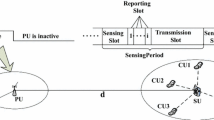Abstract
In cognitive radio (CR) networks, the secondary users (SUs) need to find idle channels via spectrum sensing for their transmission. In this paper, we study the problem of designing the sensing time to minimize the SU transmission delay under the condition of sufficient protection to primary users (PUs). Energy detection sensing scheme is used to prove that the formulated problem indeed has one optimal sensing time which yields the minimum SU transmission delay. Then, we propose a novel cooperative spectrum sensing (CSS) framework, in which one SU’s reporting time can be used for other SUs’ sensing. The analysis focuses on two fusion strategies: soft information fusion and hard information fusion. Under soft information fusion, it is proved that there exists one optimal sensing time that minimizes the SU transmission delay. Under hard information fusion, for time varying channels, the novel multi-slot CSS is derived. The performance of SU transmission delay is studied in both perfect and imperfect reporting channels. Some simple algorithms are derived to calculate the optimal sensing settings that minimize the SU transmission delay. Computer simulations show that fundamental improvement of delay performance can be obtained by the optimal sensing settings. In addition, the novel multi-slot CSS scheme shows a much lower transmission delay than CSS based on general frame structure.













Similar content being viewed by others
References
Haykin S (2005) Cognitive radio: brain-empowered wireless communications. IEEE J Sel Areas Commun 23(2):201–220
Meng J, Yin W, Li H, Hossain E, Han Z (2011) Collaborative spectrum sensing from sparse observations in cognitive radio networks. IEEE J Sel Areas Commun 29(2):327–337
Ganesan G, Li Y (2007) Cooperative spectrum sensing in cognitive radio, part I: two user networks. IEEE Trans Wirel Commun 6(6):2204–2213
Ganesan G, Li Y (2007) Cooperative spectrum sensing in cognitive radio, part II: multiuser user networks. IEEE Trans Wirel Commun 6(6):2214–2222
Yücek T, Arslan H (2009) A survey of spectrum sensing algorithms for cognitive radio applications. IEEE Commun Surv Tutorials 11(1):116–130
Stotas S, Nallanathan A (2012) On the throughput and spectrum sensing enhancement of opportunistic spectrum access cognitive radio networks. IEEE Trans Wirel Commun 11(1):97–107
Liang Y-C, Zeng Y, Peh ECY, Hoang AT (2008) Sensing-throughput tradeoff for cognitive radio networks. IEEE Trans Wirel Commun 7(4):1326–1337
Peh E, Liang Y-C, Guan YL, Zeng Y (2009) Optimization of cooperative spectrum sensing in cognitive radio networks: a sensing-throughput tradeoff view. IEEE Trans Veh Technol 58(9):5294–5299
Shi Z, Teh KC, Li KH (2013) Energy-efficient joint design of sensing and transmission durations for protection of primary user in cognitive radio systems. IEEE Commun Lett 17(3):565–568
Li X, Cao J, Ji Q, Hei Y (2013) Energy efficient techniques with sensing time optimization in cognitive radio networks, In: Proceedings of IEEE Wireless Communications and Networking Conference
Hu H, Zhang H, Yu H, Xu YY, Li N (2013) Minimum transmission delay via spectrum sensing in cognitive radio networks, In: Proceedings of IEEE Wireless Communications and Networking Conference
Althunibat S, Palacios R, Granelli F (2012) Performance optimization of soft and hard spectrum sensing schemes in cognitive radio. IEEE Commun Lett 16(7):998–1001
Quan Z, Cui S, Sayed AH (2008) Optimal linear cooperation for spectrum sensing in cognitive radio networks. IEEE J Sel Top Signal Process 2(1):28–40
Quan Z, Cui S, Sayed AH, Poor HV (2009) Optimal multiband joint detection for spectrum sensing in dynamic spectrum access networks. IEEE Trans Signal Process 57(3):1128–1140
Ganesan G, Li Y, Bing B, Li S (2008) Spatiotemporal sensing in cognitive radio networks. IEEE J Sel Areas Commun 26(1):5–12
Yu H, Tang W, Li S (2011) Optimization of cooperative spectrum sensing with sensing user selection in cognitive radio networks. EURASIP J Wirel Commun Netw 2011(208):1–8
Vu-Van H, Koo I (2011) Cooperative spectrum sensing with collaborative users using individual sensing credibility for cognitive radio network. IEEE Trans Consum Electron 57(2):320–326
Beaulieu NC, Chen Y (2010) Improved energy detector for cognitive radios with randomly arriving or departing primary users. IEEE Sig Process Lett 17(10):867–870
Atapattu S, Tellambura C, Jiang H (2011) Energy detection based cooperative spectrum sensing in cognitive radio networks. IEEE Trans Wirel Commun 10(4):1232–1241
Han W, Li J, Tian Z, Zhang Y (2010) Efficient cooperative spectrum sensing with minimum overhead in cognitive radio. IEEE Trans Wirel Commun 9(10):3006–3011
Sun C, Zhang W, Letaief KB (2007) Cooperative spectrum sensing for cognitive radios under bandwidth constraints, In: Proceedings of the IEEE Wireless Communications and Networking Conference (WCNC07)
Author information
Authors and Affiliations
Corresponding authors
Additional information
This work is supported by the National Fundament Research of China (973 No. 2009CB3020400) and Jiangsu Province Natural Science Foundation under Grant BK2011002.
Rights and permissions
About this article
Cite this article
Hu, H., Zhang, H. & Yu, H. Efficient Spectrum Sensing with Minimum Transmission Delay in Cognitive Radio Networks. Mobile Netw Appl 19, 487–501 (2014). https://doi.org/10.1007/s11036-014-0528-5
Published:
Issue Date:
DOI: https://doi.org/10.1007/s11036-014-0528-5




